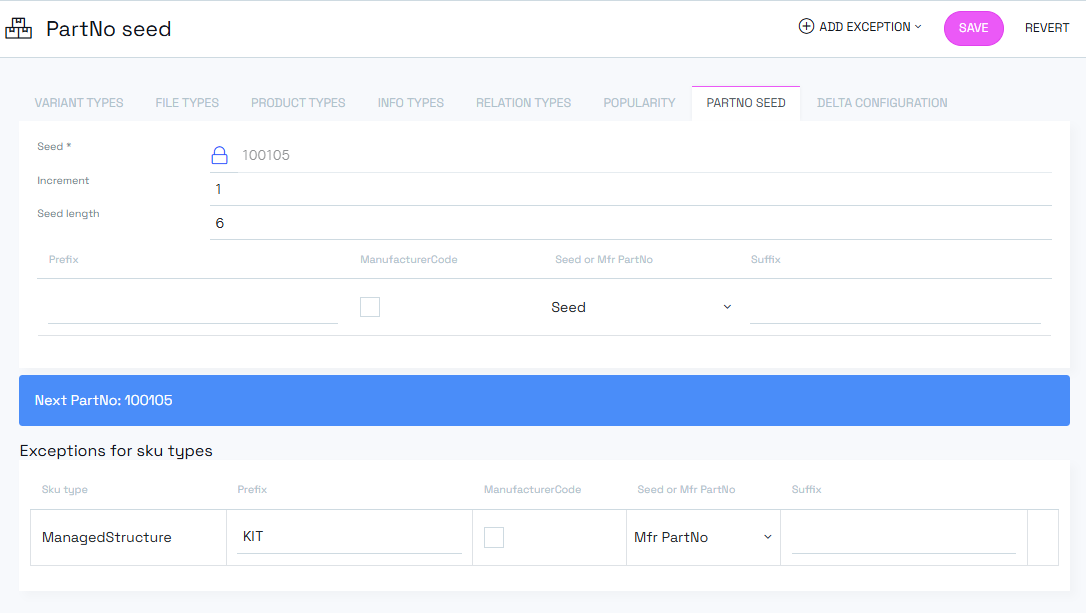The PartNo Seed page allows you to define how Norce should automatically generate part numbers for new products created directly in the system. While many solutions import products with pre-existing part numbers from external systems like ERPs, this functionality becomes essential when creating certain product types directly within Norce.

Part number generation serves multiple purposes in Norce:
- Direct product creation: Generate unique identifiers for products created in Norce
- System integration: Ensure no conflicts with part numbers from external systems
- Product identification: Create recognizable patterns that identify Norce-generated products
- Manufacturer integration: Use manufacturer part numbers as the basis for system part numbers
Norce supports two primary approaches to part number generation:
The default method uses a numerical seed that increments for each new product:
- Starting point: Default begins at 100000
- Increment: Increases by 1 for each new product
- Customizable: Can be changed to any starting number (e.g., 1000000 or 10000000)
Uses existing manufacturer part numbers as the foundation:
- Source: Based on manufacturer part numbers already in the system (for supplier products), created from an import, or manual input.
- Uniqueness: Each manufacturer code + manufacturer part number combination must be unique
- Requirements: Products must have manufacturer part numbers assigned
- Default: 100000
- Purpose: Provides separation from typical ERP system numbering
- Customization: Unlock the field to set custom starting values
- Use cases: Set to a higher value to ensure no conflicts with other systems, if needed
Add identifying text to generated part numbers:
- Common prefixes: "NO" (Norce), "NC" (Norce Commerce)
- Purpose: Immediately identify products created in Norce
- Flexibility: Use any prefix or suffix that matches your naming conventions
When using manufacturer part numbers:
- Recommended: Include manufacturer code to ensure uniqueness
- Exception: Only omit if you're certain manufacturers will never create duplicate part numbers
- Format: Typically combines manufacturer code + manufacturer part number
Create specific rules for different product types:
- Access exceptions: Click "Add Exception" button
- Select product type: Choose from previously defined product types
- Custom rules: Set different prefixes, suffixes, or generation methods
- Use case: Some product types from ERP, others created directly in Norce
Example Exception Setup:
- Product Type: "Managed Structure" or "Bundle"
- Prefix: "BU" or "BUNDLE"
- Method: Seed
- ERP products: Import with existing part numbers
- Norce-created products: Use seed generation with identifying prefixes
- External assortments: Base on manufacturer part numbers
- High starting seeds: Use 1000000 to avoid ERP number ranges
- Identifying prefixes: Mark Norce-generated products clearly
- Audit trails: Easy identification of product sources
- Standard products: Default seed method
- Bundles/Kits: Custom prefixes like "BU" or "KIT"
- Special types: Unique naming conventions per type
- Assess your environment: Determine if you need part number generation
- Check external systems: Identify existing part number ranges
- Set starting seed: Choose a safe starting number
- Define prefixes: Create identifying patterns for Norce products
- Navigate to the Part Number Seed page
- Unlock the seed field if needed
- Set your desired starting number
- Add prefixes or suffixes as required
- Choose between seed method and manufacturer part number method
- Ensure product types are defined before creating exceptions
- Click "Add Exception" to see available product types
- Select the product type needing special handling
- Configure custom prefixes, suffixes, or methods
- Save your exception rules
- Ensure all relevant products have manufacturer part numbers
- Switch generation method from seed to manufacturer part number
- Consider adding manufacturer code for uniqueness
- Test with a sample product to verify the format
- Products must have unique part numbers across the entire system
- Manufacturer part numbers require associated manufacturer codes for uniqueness
- Exception rules apply only to previously defined product types
- Changes affect new product creation immediately
- Existing products retain their current part numbers
- External system integrations may need updates if numbering changes
- External systems may rely on specific part number formats
- Cannot change existing product part numbers through this page
- Exception rules are tied to product type definitions
- Manufacturer part number method requires complete manufacturer data
Important: Always test your part number generation strategy with sample products before implementing in production. Consider the impact on existing integrations and external systems when making changes to your numbering scheme.